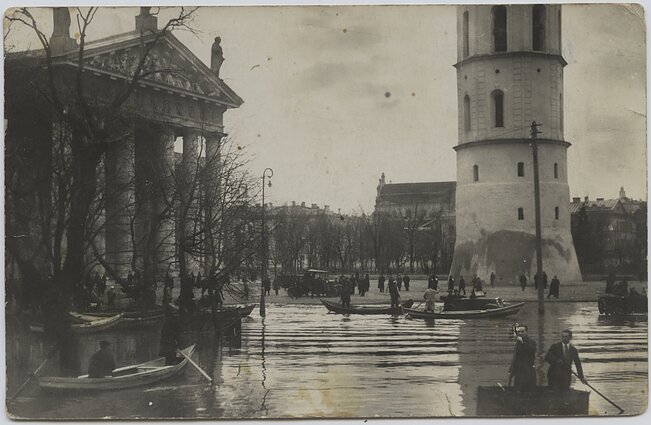
In January of this year, Lithuanian historian Dr. Vitalija Stravinskienė, head researcher at the Institute of History, gave an interesting lecture called “Putting together an ethnic mosaic: the transformation of Vilnius in the 20th century” at the Vilnius Museum. LRT.lt provided a summary of how Vilnius changed.
At the end of the 19th century, Jews were the largest ethnic group in Vilnius. They were followed by Poles, Russians, Belarusians, and Lithuanians. At the end of the 19th century, every second inhabitant was Jewish. But after World War I, due to certain political decisions and the restriction of the right of Jews to return to Vilnius, their number decreased, and the Polish population began to dominate. During World War I, about 90,000 people, including many Jews, left Vilnius as the German army approached. When the war ended, Polish authorities who had taken hold of the city were reluctant to let them back in.
During World War II, the city and its population changed again. The Nazi occupation resulted in the extermination of approximately a third of Vilnius residents – the remaining Jews. When the Soviets reoccupied Lithuania, their radical social, political, and cultural policies led to the Russian speakers overtaking the Lithuanian population in Vilnius.
In 1951, officials of the Interior Ministry registered all the residents of Vilnius, finding that almost 180,000 people lived in the city, and 75 percent of them were of Slavic nationality: Russians, Poles, Ukrainians, and Belarusians. Only a quarter were Lithuanians, who became the most numerous group in the late 1960s, and this situation continues until today.
According to the historian, the most important factors that determined the ethnic mosaic of Vilnius in the 20th century were the political decisions, socio-economic changes, and the phenomenon of territorial expansion. As Polish Marshal Józef Piłsudski said, “Everyone wanted Vilnius”. It was a city where the interests of several states and peoples crossed.” Between 1914 and 1989, the political power in Vilnius changed 13 times.
Socio-economic changes, such as agricultural reforms, also played an important role. When the Soviet government began to create collective farms in Lithuania from 1948-1949, people from the countryside began to seek refuge and escape in the cities, and the number of Vilnius residents increased. Everyone tried to find an easier, more comfortable life and to avoid the hated, imposed collective farms.
Natural disasters and epidemics also left a mark on the city. There were great fires when Vilnius was almost destroyed. A flood in interwar Vilnius was a natural disaster. The rising waters swept away several thousand wooden houses and filled up wells, and there was a risk of epidemics. Floods also struck Vilnius in 1951 and 1956.
These factors are directly related to the changes in the status of the city and the phenomenon of territorial expansion. In the years of the first independence, Vilnius was a peripheral city. “When Vilnius became part of Lithuania and its legal capital in 1939, this led to a desire to settle in Vilnius. […] In the interwar period, it was perceived that although Vilnius was the fourth cultural capital of Poland, it was an extremely backward city – a land without industry, a purely agricultural land,” Stravinskienė said.
She pointed out several events that completely changed the composition of Vilnius’ population. The first was the Holocaust in 1941-1944. Before WWII, a third of Vilnius inhabitants were Jewish. The Nazis and their collaborators destroyed more than half of them in the first months of the occupation. Of the 60,000 Jews in Vilnius, about 33,000 of them were killed.
The second shock was the relocation to Poland of Polish Jews and former Polish citizens who survived the Holocaust, which was implemented by the Soviet authorities. The Soviet Union came up with the great population transfer as part of the East-Central European unification plan, which included almost all countries and many peoples: Germans, Poles, Hungarians, Belarusians, Ukrainians, Russians, Lithuanians from Poland. The decision to relocate the Poles was taken in 1943 at the Tehran Conference of the Allied powers, allowing the borders of post-war Europe to be reorganized, and Poland’s border to be based on the Curzon Line. “The Polish population had to make a choice – either to leave for a geographically new Poland, or to stay and become citizens of Soviet Ukraine, Soviet Belarus, or Soviet Lithuania,” Stravinskienė said. The official name of the relocation operation was “evacuation”. Scholars have given it various names, ranging from resettlement and deportation to ethnic cleansing. “This is a matter of interpretation,” she added.
In 1945, more than 56,000 Vilnius residents left for Poland, with an additional 32,000 leaving in 1946. At first, the Poles delayed and tried to sabotage the transfer, hoping that the international situation would change, and Vilnius would remain part of Poland. But the Soviet authorities stepped in and a relocation plan was drawn up, indicating the exact time when a person had to leave. “If a person did not leave for objective reasons, such as illness or if they were not dismissed from work, they lost their right to leave and became Soviet citizens with an obligation to stay.”
After 1946, there were about 30,000-35,000 old residents remaining in Vilnius. Some 15,000-20,000 Poles also remained. There were about 8,000-10,000 Lithuanians and a similar number of Russians and Belarusians combined.
At the beginning of 1945, special resolutions were passed to replace the departing Poles with inhabitants from other Lithuanian districts, towns, and villages. It was planned that some 30,000 people could relocate to Vilnius within a few months. The historian noted that the decisions were taken at the wrong time. The transfer of Poles was not in full swing yet, and Lithuanian newcomers had nowhere to stay when they arrived. The planners had miscalculated. They decided to mobilize only 12,000 people, but in reality, only about 2,000 arrived.
At the end of the Soviet era, the number of Vilnius inhabitants had reached almost 600,000.
Migration led to the rapid growth of the city. Vilnius was a major city, a centre of attraction for various Soviet regions. At the time, there were 96 ethnic minority groups in Vilnius, with 100 or more members.
About 20,000 inhabitants were also added by the authorities’ decisions to expand Vilnius territory. A major expansion of the city’s territory took place in 1968, when the inhabitants of the surrounding villages, that are today the residential neighbourhoods of Viršuliškės, Fabijoniškės, Pilaitė, suddenly became Vilnius residents.



























